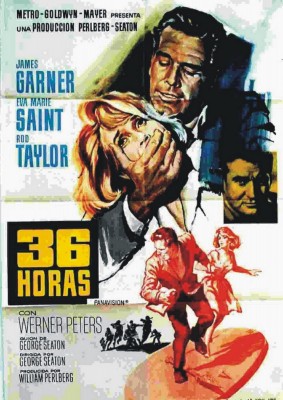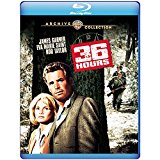| Reviews & Columns |
|
Reviews DVD TV on DVD Blu-ray 4K UHD International DVDs In Theaters Reviews by Studio Video Games Features Collector Series DVDs Easter Egg Database Interviews DVD Talk Radio Feature Articles Columns Anime Talk DVD Savant Horror DVDs The M.O.D. Squad Art House HD Talk Silent DVD
|
DVD Talk Forum |
|
|
| Resources |
|
DVD Price Search Customer Service #'s RCE Info Links |
|
Columns
|
|
|
36 Hours
Gorgeously photographed in black-and-white Panavision, 36 Hours looks phenomenal on Blu-ray, though it's short on extras.
U.S. Army Intelligence Maj. Jeff Pike (James Garner), having attended the top secret briefing on the imminent Invasion of Normandy just days away, is ordered to fly to Lisbon to meet an informant to confirm that the Nazis still mistakenly believe the landing will occur at Pas de Calais, where they've committed most of their defenses.
Pike waits for the man at a café, but his coffee has been drugged and he collapses. Unconscious, he's smuggled out of Portugal and flown to Germany. He awakens in a U.S. Army hospital and told by psychiatrist Maj. Walter Gerber (Rod Taylor) and nurse Anna Hedler (Eva Marie Saint) that he's been suffering from sporadic amnesia since being tortured in Lisbon. It's 1950, they say, and that he's in Occupied Germany, the Normandy Invasion having been a smashing success, ending the war in late-1944, some six years ago.
Of course - and the movie reveals this from the start - it's all an elaborate ruse to get Pike to reveal all the details about the invasion as part of his "recovery." Gerber leaves nothing to chance, enlisting specialists to lightly gray some of Pike's hair and weakening his vision so that he requires reading glasses. Newspapers with stories about ex-President Roosevelt and current President Henry A. Wallace are scattered about, and everyone at the hospital speaks perfect American-accented English, except for Anna, a concentration camp survivor. However, despite many previous successes with minor POWs, Gerber is under the gun, with the SS is anxious to extract the details from Pike using conventional torture methods, allowing Gerber just 36 hours to obtain the precious information. After that, pragmatic SS agent Schack (Werner Peters) takes over. All this set-up is covered in the movie's opening 20 minutes or so.
36 Hours falls short of greatness but is extremely well done and genuinely clever in ways critics usually don't acknowledge. From the point where disoriented Pike wakes up, the movie audience is kept in suspense wondering how and when Pike will realize it's all a set-up. (Major Spoilers Ahead…) What they don't anticipate (certainly I did not) is that moment doesn't come until after Pike freely spills every single bean on his plate about D-Day. Now the picture becomes something else: How will Pike and/or others prevent this priceless information from reaching the German High Command, or convince them that the information is false? Like Robert Wise's The Hindenburg (1975), the suspense builds and continually mutates in such a way that one almost forgets the already-decided outcome of these events, that the Germans didn't realize their mistake, or that George C. Scott couldn't prevent the Hindenburg from blowing up.
Further disorienting viewers nearly as much is that fact that Rod Taylor was an Australian playing a German impersonating an American. In a few scenes he speaks German to his superiors, and toward the end he switches from his U.S. Army doctor's uniform to a German Luftwaffe one, but at all times he's very convincing.
The movie's plot, and Taylor's character particularly are wildly improbable almost to the point of being absurd but Taylor, who stands out in the film, even above Garner, sells it magnificently. His screen persona, tough and masculine but gentle and reassuring almost to the point of sweetness, made him as perfect for 36 Hours as his signature roles in The Time Machine and Hitchcock's The Birds. "Good German" characters are almost impossible to play, but Taylor succeeds in winning the audience's sympathy, even though he's working harder than anyone else trying to extract top secret info for Nazis.
By contrast, Garner is playing against type. Perhaps self-consciously double-crossing audiences expecting Pike, after realizing he's been had, to turn the tables on his jailers with Maverick-like élan, his character just wants to get the Hell out of there, and if possible correct the horrible mistake he's made. Eva Marie Saint's concentration camp survivor adds gravitas, but isn't as interesting and nearly as unbelievable a character as Taylor's, though she and director George Seaton's screenplay mostly pull it off acceptably by the end.
Besides Taylor, the biggest surprise of 36 Hours is the intelligent casting of Werner Peters as the SS officer. Though partly filmed on location, most of the film was apparently shot on Hollywood soundstages with ex-pat Euro actors like Oscar Beregi, Martin Kosleck, and Celia Lovsky, but for Schack they cast busy West German actor Peters, a semi-regular in two popular film series there, the Dr. Mabuse and Edgar Wallace crime thrillers. Speaking English, Peters projects understated, dogged menace.
The movie's final act is more conventional: the escape. (Including a least one shot from a location also used in Garner's The Great Escape.) Fortunately Seaton seemed to realize that this part of the movie needed something different, and so added expertly positioned comedy relief: a fat, mildly corrupt home guard German sergeant, played by John Banner. His is a marvelous vignette, so much so that it directly led to his casting as Sgt. Schultz on Hogan's Heroes.
My guess: Up until then, Banner had never played so major a supporting role in a movie, and anyway he'd specialized playing villains. Billed tenth in the credits is Sig Ruman, the once prominent character actor, here playing a brief scene with Banner as a fellow border guard. Though once a major supporting player, his role in 36 Hours lasts all of 15 seconds. He'd specialized in precisely the type of part Banner atypically plays in 36 Hours, leading me to hypothesize the 80-year-old Ruman was originally slated for Banner's role but wasn't up to it for one reason or another. Makes sense. Adding to the irony is that Schultz played a significant role in Ruman's career at least three times. In the great Lubitsch comedy To Be or Not to Be (1942) his "Concentration Camp" Col. Ehrhardt is accidentally shot by a fellow Nazi named Schultz. In Billy Wilder's Stalag 17 (1953), the basis for Hogan's Heroes, Ruman played Sgt. Schultz. And in 36 Hours he plays a scene with an actor who just might have replaced him, and who'd win pop culture immortality playing a character named - Sgt. Schultz.
Video & Audio
Filmed in crisp black-and-white anamorphic Panavision, 36 Hours on Blu-ray looks great. The blacks are really inky here and the level of detail impresses. The English 2.0 DTS-HD Master Audio likewise is excellent, really bringing out Dimitri Tiomkin's thrilling score. English subtitles are offered on this region-free disc.
Extras
The lone supplement is a trailer, which struggles but mostly succeeds in selling the film without revealing to much about it.
Parting Thoughts
Excellent, 36 Hours is Highly Recommended.
Stuart Galbraith IV is the Kyoto-based film historian largely absent from reviewing these days while he restores a 200-year-old Japanese farmhouse.
|
| Popular Reviews |
| Sponsored Links |
|
|
| Sponsored Links |
|
|
| Release List | Reviews | Shop | Newsletter | Forum | DVD Giveaways | Blu-Ray | Advertise |
|
Copyright 2024 DVDTalk.com All Rights Reserved. Legal Info, Privacy Policy, Terms of Use,
Manage Preferences,
Your Privacy Choices | |||||||














